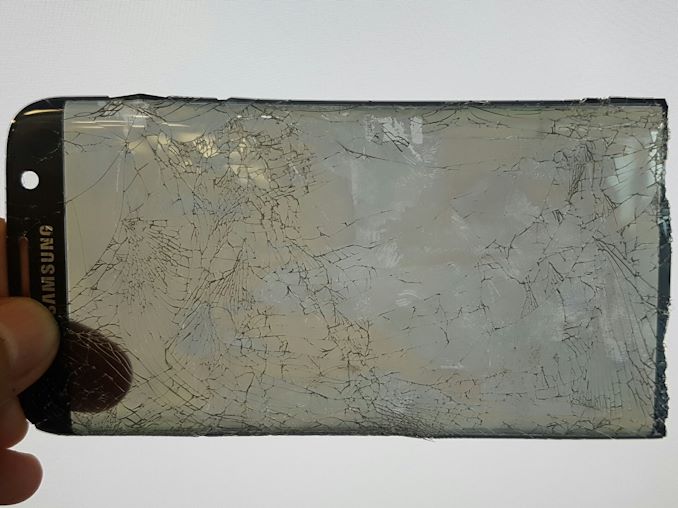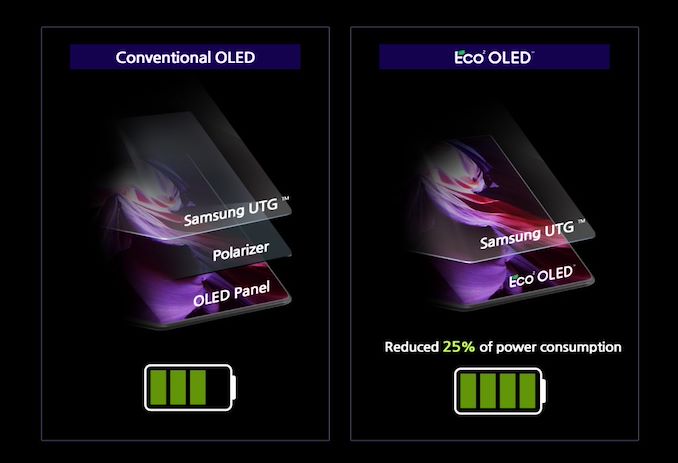Samsung Display Announces Polarizer-less OLED With 25% Less Power
by Andrei Frumusanu on August 16, 2021 12:01 PM EST- Posted in
- Mobile
- Smartphones
- OLED
- Samsung Display

Today Samsung Display Company (SDC) is announcing the introduction and mass production of a new generation of OLED panel called “Eco²OLED”. While the news here is rather short, it’s actually a massive technically undertaking and shift from past generation OLED panel technologies, as the new panel type is making due without the classical polarizer layer in-between the actual panel and cover glass.
In a traditional OLED panel, the actual panel itself is of a copper colour, which of course doesn’t work very well for displaying black. To create a reflective black, displays use polariser layers which block light from entering and reflecting off the display, only allowing light generated by the display itself to go through the glass.

Cover Glass and Polarizer on Galaxy S7
The problem with such layers is that they are of a reduced transmittance, and the polarizer itself is eating some of the light emitted by the panel. The above picture for example is the cover glass and polarizer of an old Galaxy S7, which appears notably darker than the lit background.
Samsung is explaining that they’ve managed to get rid of this polarizing layer, and are able to have non-reflective OLED panels which display as black. This is a major change in the display stack, and Samsung is quoting that they’re able to improve transmittance by a massive 33%, meaning 33% brighter screens, or at the same brightness, reduce power consumption by 25%.
These figures are massive, and should represent one of the largest jumps in power efficiency in OLEDs since their inception.
Samsung Display states that the Eco²OLED is already being used in Samsung Mobile’s Galaxy Z Fold3, meaning this should be the first phone to be able to take advantage of the technology. Along with this year’s widespread adoption of LTPO panels which massively improved power efficiency, this could signal a new large jump in smartphone power efficiency and help improve battery life of devices adopting the technology.











51 Comments
View All Comments
Wereweeb - Tuesday, August 17, 2021 - link
Quite on the contrary, I believe that in a not too distant future we will be using them to replace consumer desktop CPU's. Plug them to a monitor, boom, here's a desktop environment.Wereweeb - Tuesday, August 17, 2021 - link
And yes I'm aware this exists, but I mean as a real trend, not an under-developed curiositydontlistentome - Tuesday, August 17, 2021 - link
Had that for years with Samsung Dex. Works really well on an S10, guessing even better on the latest CPUs.The real breakthrough will be if Microsoft can get Windows 11 back on phones. There's a lot of monitors from Dell (and others) with USB C connectivity. Got a 32" Dell that works great with the S10 with the 1 cable. Giving screen+power+usb hub (for keyboard/mouse)+wired internet.
dontlistentome - Tuesday, August 17, 2021 - link
Samsun have done some deal with MS to support the Windows 365 (started around when the S10 came out, looks like it's finally getting somewhere).drajitshnew - Wednesday, August 18, 2021 - link
Have you considered that below the true 1000$ battery almost every Phone has USB 2 in USB CGC2:CS - Monday, August 16, 2021 - link
Does that mean we are getting rid of oleds coppery flares sparkles and greenish hues under sunlight ?If LCD was good in one area it was “so black you cant tell where the turned off display ends” thingy.
Spunjji - Tuesday, August 17, 2021 - link
Sounds like it!zamroni - Monday, August 16, 2021 - link
It's good reading below.IEEE predicts quantum dot based display will be the future over oled.
https://spectrum.ieee.org/your-guide-to-television...
coburn_c - Monday, August 16, 2021 - link
Quantum Dots still need a light source dummyWereweeb - Tuesday, August 17, 2021 - link
No they don't dummy. There are self-emissive QD's being developed.